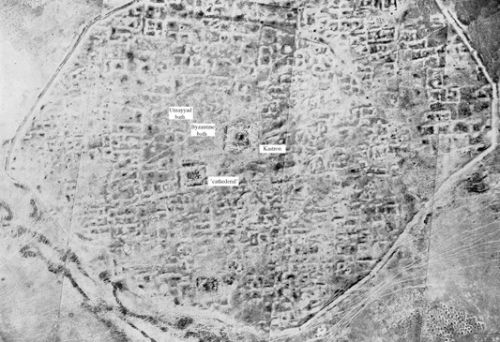Androna / Andarin : The Oxford Project
Dr. Marlia Mango (Director) - marlia.mango@sjc.ox.ac.uk
Priscilla Lange (Research Assistant) - contact via fergus.millar@classics.ox.ac.uk
Marlena Whiting (Research Assistant) - marlena.whiting@lincoln.ox.ac.uk
The Site
Androna, modern al-Andarin, is first attested as a mansio on the Chalcis-Palmyra route by the late 3rd century AD. Preliminary exploration was carried out in 1905 by the Princeton Archaeological Expedition under H.C. Butler. The site was viewed within a wide regional context in the 1930s by R. Mouterde and A. Poidebard’s aerial survey of the so-called ‘Limes of Chalcis', and more recently by the Syrian-French Marges Arides survey. Androna is an outstanding example of a very large late antique kômê, so identified in a 5th–6th-century mosaic inscription. At 160 ha, it is of massive size for a village, and had certain urban features, such as two sets of circuit walls and large extra-mural reservoirs. Its communal buildings included a kastron, a Byzantine bath, and nearly a dozen churches. Another bath was built in the Umayyad period. The entire space within the circuit walls is filled with collapsed buildings best seen in aerial photographs and satellite images. More than 50 Greek inscriptions, mostly of the 6th century and mentioning a total of ca 30 individuals, are known. In the 13th century (1225) the Arab geographer Yakut wrote that the site was in ruins.
Androna, situated on the western edge of the north Syrian steppe, between Aleppo and Hama, lies between coastal and semi-desert climates in a zone with only 250-300 mm rainfall. Its expansion, from perhaps a simple mansio, required the installation of qanat/reservoir irrigation systems, probably as part of a deliberate development programme, possibly linked to nearby militarized cities such as Chalcis, although there is no epigraphic evidence to support direct state activity at Androna itself. The growth of this large settlement towards the end of Roman rule in the Levant has wide historical, social and economic implications.

The International Project
The current archaeological work at Androna 1997-2007 aims to distinguish and date its developmental phases and to place it within its environmental context. This international project is being carried out by three independent teams from the Syrian Department of Antiquities (director Dr. R. Ugdeh), the University of Heidelberg (director Prof. C. Strube), and the University of Oxford (director Dr. M. Mango). Faced with a large site, these teams have concentrated in key areas in its centre and on its periphery. Following topographical survey (1997), excavation began (1998) in the centre of the site of three prominent communal/public buildings, two of them dated by inscriptions: the kastron of 558-9 (Heidelberg), the Byzantine bath of ca 560 (and the street between them) (Oxford), and an Umayyad bath (Syrian team). Excavation of domestic complexes (one dated 583/4) began in 2001 (by Heidelberg) and 2005 (by the Syrian team). Two key areas on the site's periphery have been investigated – the two sets of circuit walls (by Heidelberg) and the extra-mural reservoirs (by Oxford).
Oxford's Study of Water Use
Within the project's overall scheme, Oxford's work has concentrated on Androna's water management and agriculture. Accordingly, we have excavated the Byzantine bath as well as major parts of the SE and NW extra-mural reservoirs, and planned two other reservoirs. We have also carried out a survey of water flow in the two excavated reservoirs and one of the six qanat systems. Oxford’s landscape study of the area around Androna, started in 2004, has produced evidence of agricultural activity and small-scale nearby settlement, as well as a martyrium and a stylite’s column.
Funding
The Oxford project at Androna has been funded by generous grants from the Craven Committee Oxford; St. John’s College Oxford; Council for British Research in the Levant London; Dumbarton Oaks Washington, DC (Harvard University); Research and Equipment Committee Oxford; Society of Antiquaries London; McCabe Family Foundation; British Academy London; Society for the Promotion of Roman Studies London; Joanna Sturm; History Faculty Oxford; Meyerstein Fund Oxford; Near Eastern Studies Programme Oriental Studies Oxford.
Contact Details
For further information, please contact:
Dr. Marlia Mango (Director) - marlia.mango@sjc.ox.ac.uk
Priscilla Lange (Research Assistant) - contact via fergus.millar@classics.ox.ac.uk
Marlena Whiting (Research Assistant) - marlena.whiting@lincoln.ox.ac.uk

